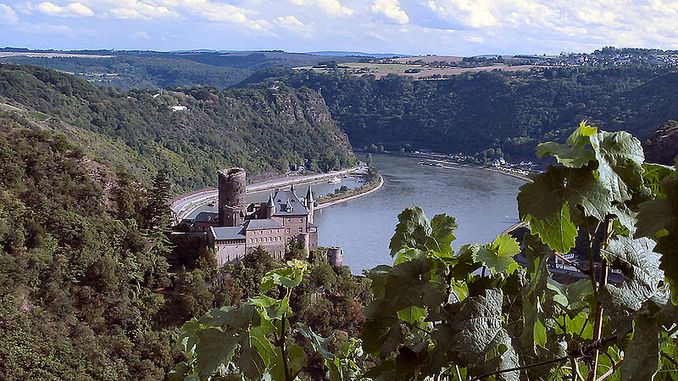
The Siebengebirge is on the northern border of the Middle Rhine Valley, which begins at Bingen / Rüdenheim. For many people, the narrow valley with its steeps, vineyards and numerous castles is the classical Rhine landscape par excellence, and the epitome of the “Romantic Rhine”. This applies especially to the Upper Middle Rhine Valley between Bingen and Koblenz. Since 2002 it is a UNESCO World Heritage Site.
Heinrich Heine’s Lorelei poem “I know not if there is a reason why I am so sad at heart” is world-famous. Heine loved his native Rhineland, and it made him sad and angry at the same time that chauvinists tried to use the Rhine for their purposes.
Romantic Rhine
The Middle Rhine Valley has attracted tourists since the 19th, even late 18th century. Among them were Thomas Jefferson, Lord Byron and William Turner, just to name a few. Yet, the “Romantic Rhine” is a relatively new phenomenon. For two millennia, the Rhine has been one of the main traffic routes. During the time of the Roman Empire, the Rhine was both a lifeline for the Roman provinces and its border against the “barbarians” on the right bank. Trade ships brought goods and merchandise and the fleet patrolled on the Rhine, from Switzerland to Holland. Many cities along the Rhine were founded by the Romans, among them the former provincial capitals Mainz and Cologne.
An eventful history
In our days, the large number of medieval castles greatly contributes to the special charm of the Middle Rhine valley. As medieval travelers, however, we might have gone to wreck and ruin. Here, four of the seven prince-electors of the Holy Roman Empire – the archbishops of Cologne, Mainz, and Trier and the Count Palatine of the Rhine – held territories, and also many regional dukes. The map was a patchwork, and most rulers had castles built to secure their territory against the others. Castle names like “Burg Katz” (Cat Castle) and “Burg Maus” (Mouse Castle) or “Feindliche Brüder” (hostile brothers) give an idea of the tensions and hostilities back then.
Then the princes and dukes at Rhine discovered customs as a source of revenue. Therefore, they had toll castles built, no ship could pass their territory without paying. Just think of Pfalzgrafenstein castle at Kaub, built on an island in the Rhine. Sooneck Castle was considered a veritable robber’s den.
With the advent of firearms the time of castles was over. Many were abandoned and gradually fell apart, so the mighty castle on Mount Wolkenburg in the Siebengebirge. During the Thirty Years’ War numerous castles were destroyed, among them those on Mount Drachenfels and Mount Löwenburg. In the Nine Years’ War, the mercenary troops of King Louis XIV of France destroyed what still stood. Fortunately, the Marksburg castle over Braubach survived unscathed, and we can visit it today.
The Hohenzollern family on the Rhine
After the Napoleonic Wars, the Rhineland fell to Prussia. On the mountain on the east bank of the Rhine opposite Koblenz the Prussians built the mighty fortress Ehrenbreitstein. We owe it to US Major General Henry Tureman Allen that it wasn’t destroyed during the Rhineland occupation after World War I.
The gifted Prussian architect and painter Karl Friedrich Schinkel rendered outstanding services not only to the Prussian capital Berlin, but to all Prussian provinces. In the Rhine Province, he took care of Stolzenfels Castle and the Cologne Cathedral.
Soon many castles along the Rhine were in the hands of the Hohenzollern family, among others Stahleck, Rheinfels, Rheinstein, the Rolandsbogen and the Godesburg. In Rolandseck, a palace with its railway station was built for the later emperor William I.
Latin heritage
Let us once again refer to our Latin heritage. “Gallis et omnibus Hispanis ac Brittannis hinc permisit, ut vites haberent vinumque conficerent”, reads a decree by emperor Probus (272-282), in which he allowed the cultivation of wine in the Germanic provinces. And the Middle Rhine wine region has a lot to offer indeed!
Impressions from the Middle Rhine | Read more
Welterbe Mittelrheintal (German)
Reference
The photo of Burg Katz if from the German Wikipedia.
Das nachfolgend aufgeführte Fotos stammt aus der freien Enzyklopädie Wikipedia und steht unter der GNU-Lizenz für freie Dokumentation: Mittelrhein/Burg Katz Urheber.

Be the first to comment